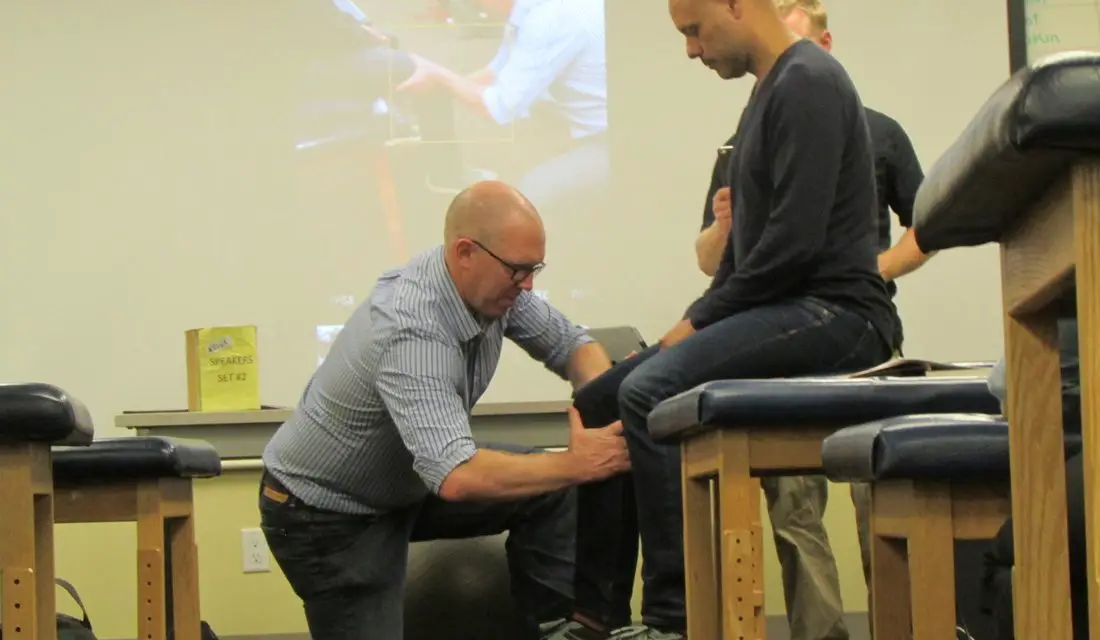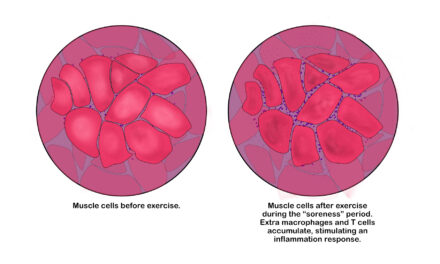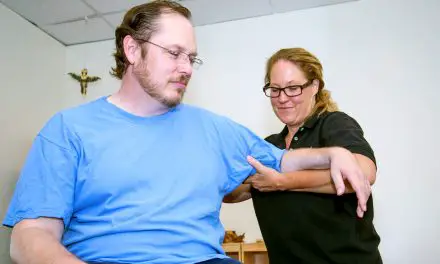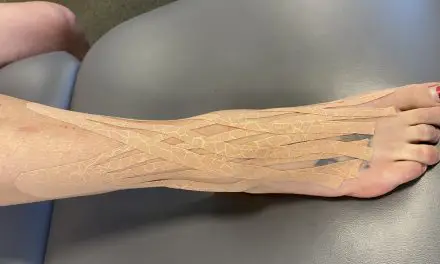About 25% of U.S. adults experience some type of knee pain, an increase of 65% since the late 1990s. Pain from bending the knee often stems from several causes rather than just one, such as osteoarthritis, nerve impingement, bursitis, and a partial medial or lateral meniscus tear.
Overlapping symptoms can make diagnosis and treatment difficult. Therefore, screening for your knee pain to rule out more serious and common conditions can help you and your physician or physical therapist determine the best treatment plan.
Anterior knee pain
Pain in the front of the knee is one of the most common types of knee pain, especially among running athletes. These include:
Jumper’s knee: Also known as patellar tendinopathy, jumper’s knee is often caused by repetitive landing, jumping, acceleration, and deceleration that increase the risk of getting tears in the patellar tendon.
Although a jumper’s knee may involve any part of the knee tendon, the most affected part is toward the kneecap where it meets the quadriceps tendon. Thus, many activities that require bending, such as stair climbing or standing up from a sitting position, would cause pain.
Patellofemoral pain syndrome (PFPS): Sometimes called “runner’s knee,” PFPS is often felt in the front of the knee, usually beneath or around the kneecap. The pain can worsen with squatting, walking, or just sitting with the knees bent.
PFPS can be caused by a quick and heavy increase in knee loading (such as in load volume and intensity), weakness of thigh and hip muscles, poor motor control of the hip and knee muscles, and increased mobility of foot pronation. However, there’s still debate among researchers and clinicians whether the last three factors are significant enough to be considered as relevant risk factors.
While the symptoms sometimes come and go or can go away by themselves, PFPS can become chronic and can impede or discourage you from exercise or moving, which may create a merry-go-round cycle that can worsen pain and function.
ACL tear: The two types of ACL tears are partial tears, where the ligament is only partially torn and some fibers remain intact, and complete tears, where the ligament is completely torn.
Like a jumper’s knee, pivoting, turning, and sharp movements of the knee increase the likelihood of getting an ACL tear. The knee may buckle if you try to stand.
Posterior knee pain
While posterior knee pain is less common, the approach to understanding knee pain and its treatments are not that different. It can stem from not only nerves or inflammation but also from nearby body parts, such as the hamstrings.
Baker’s cyst: A Baker’s cyst, or a popliteal cyst, is the inflammation of one of the bursae of the knee. This is often caused by rapid accumulation of the fluids in the bursa, which may lead to inflammation from constant rubbing of the muscles and tendons during movement. While this is more common among adults with a history of knee or leg trauma, a Baker’s cyst can develop with other joint diseases and disorders, such as arthritis and meniscus tears.
The knee does not always hurt when it bends, but it can rupture under internal or external pressure. The fluid seeps into surrounding tissues and down the leg, causing a sharp pain in the calf muscle. This can be mistaken for deep vein thrombosis.
PCL tear: Injuries to the posterior cruciate ligament (PCL) is less common than other posterior ligament injuries because the PCL is the largest and thickest ligament, which makes it more resistant to tears. However, it can still tear from impact to the tibia while the knee is flexed or twisting of the knee while it’s hyperextended.
Symptoms include swelling or achiness behind the knee, dull pain when bending the knee, and instability in the knee, which may feel “looser” than normal. Keep in mind that some PCL tears are asymptomatic
Hamstring strain: A tear in the hamstring muscle near the pelvis may cause pain in the back of the knee. Such strain can be caused by eccentric contraction of the hamstring, which is the lengthening of the muscle under tension. Other causes can be fatigue and previous hamstring injuries.
Lack of flexibility or tight hamstrings seem to be obvious reasons, but there’s no good quality evidence that they are significant causes of getting a strain. Stretching has almost no effect on lowering the risk of hamstring strains.
Deep vein thrombosis (DVT): DVT is blood clot along one of the veins that run from the hip to the lower leg. Symptoms may be pain behind the knee with swelling and reddish, hot skin at the site of the clot. Other symptoms may be similar to a heart attack, such as chest pain, discomfort that worsens with coughing or deep breathing, troubled breathing, irregular heartbeat, and very low blood pressure.
However, the CDC reports that about half of the people who have DVT do not have such symptoms. These people would not know they have it until the blood clot reaches one of the lungs, which is called pulmonary embolism. This can be fatal and would need emergency care.
DVT requires immediate medical attention and a change in lifestyle to minimize the risk of a recurrence.
Medial knee pain
Medial meniscus tear: This is a tear to the meniscus at the inner knee, often caused by a sharp strike to the outer knee. However, medial meniscus tears can be caused by degenerative sources, such as aging and normal wear-and-tear.
Symptoms include the locking of the knee pain, which prevents it from bending, stiffness when walking, and the feeling that your knee is going to “give out” beneath you when you stand or walk.
MCL injury: Injury or tear to the medial collateral ligament (MCL) are commonly caused by external force toward the outer knee. However, internal factors, such as pivoting and turning of the knee can increase the risk of a MCL tear.
Symptoms may be similar to an ACL tear, there’s usually a popping sound at the time of the injury. So if there is no such sound, it’s likely a MCL tear. A MRI scan can tell what kind of injury this is.
Pes anserine bursitis: Pes anserine bursitis is an irritation to the bursa that is enlarged and inflamed. It’s more difficult to diagnose and treat because it often has overlapping symptoms with other types of knee pain.
The pes anserine bursa is between the tibia and the tendinous attachments about a few centimeters below the medial joint line. Symptoms include pain in the outer knee below the knee joint when the knee bends repeatedly.
Lateral knee pain
Lateral meniscus tear: A rapid change from knee flexion to extension can increase the risk of tearing the lateral meniscus. Such tears can also happen among athletes who play contact sports where their feet are planted on the ground and are tackled from the side. Tenderness and sharp pain in the outer knee are often some of the symptoms when the knee is touched or is bending.
LCL injury: The lateral collateral ligament (LCL) is also prone to injury, most likely in the form of a tear or sprain. Like medial meniscus tears, it is often caused by a sharp impact but to the inner knee instead of the outer knee. Sometimes sharp pivots of the knee can cause the ligament to tear. Symptoms are similar to MCL tears but they are usually felt on the outer knee.
Does poor knee alignment cause pain?
Poor knee alignment—or sometimes called “patellar tracking”—is often blamed for knee pain. Manual therapists will likely try to do everything they can to “align” your kneecap with the femur and tibia with manual adjustments, specific exercises, taping, stretching, strapping, and bracing. Surgeons would try to reattach the patellar tendons to realign your knee.
However, scientific evidence in the past 20 years find no strong strong relationship between knee alignment and knee pain, contradicting what is often taught in medical and manual therapy schools and what is believed in practice.
A 2019 systematic review examined 15 studies that found that healthy, painless knees are “extremely variable.” This means there’s no ideal alignment that dictates a painful or non-painful knee. Six months later, the same researchers published another systematic review that osteoarthritic knees also have high variability of knee alignment whether the knees are painful or not.
With such variability in how each person’s knees move and are aligned, clinicians should be more cautious about making cause-and-effect claims about knee alignment and pain.
Knee pain treatment
Because knee pain is often caused by many factors, based on the biopsychosocial nature of pain, there should be multiple options for patients and clinicians to have. Common interventions for most knee pain are:
- Medications
- Physical therapy
- Exercise
- Bracing
- Corticosteroid injection,
Most of these offer short-term pain relief, and different types of knee pain will very likely need different types of treatments.
Even so, treating the knee joint only without much consideration about the patient is short-sighted. While the diagnosis behind knee pain should be different in each patient, the treatment of the person should be universal—not that much different than treating patients with hip pain or back pain.
For example, if a massage therapist gets five patients with chronic knee pain, and each person has a different diagnosis, the massage treatment and the assessment may be different for each person. However, the basic human interaction between the therapist and the patient should be about the same: giving reassurance, listening, asking questions, and being supportive.
This article is for information purposes only and is not a substitute for your medical advice nor is it a reason for a self-diagnosis.
Further reading
How Massage Can Help Treat Chronic Pain
Descending Modulation: How Massage Therapy Can Alleviate Pain
A native of San Diego for nearly 40 years, Nick Ng is an editor of Massage & Fitness Magazine, an online publication for manual therapists and the public who want to explore the science behind touch, pain, and exercise, and how to apply that in their hands-on practice or daily lives.
An alumni from San Diego State University with a B.A. in Graphic Communications, Nick also completed his massage therapy training at International Professional School of Bodywork in San Diego in 2014.
When he is not writing or reading, you would likely find him weightlifting at the gym, salsa dancing, or exploring new areas to walk and eat around Southern California.





